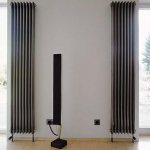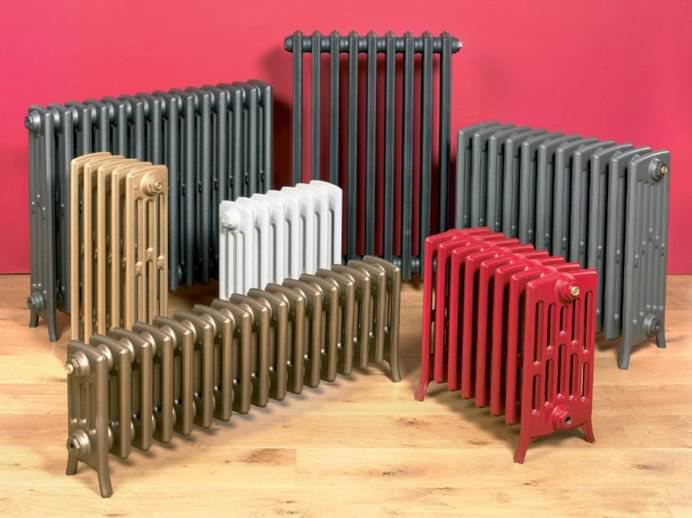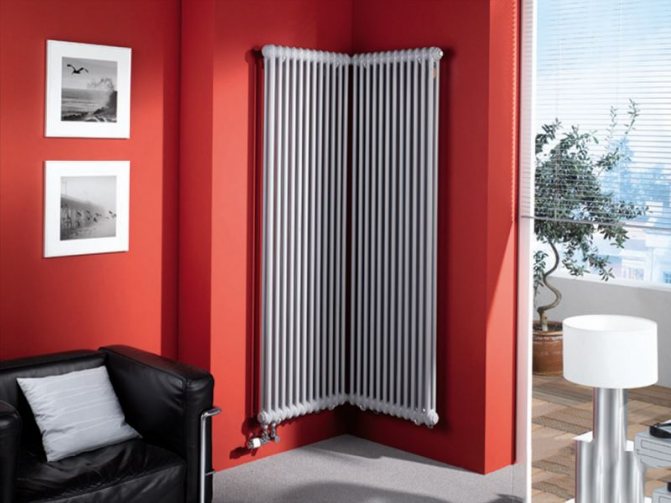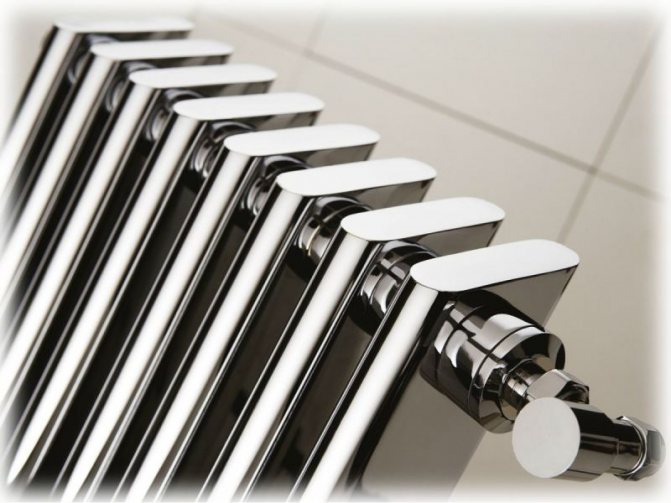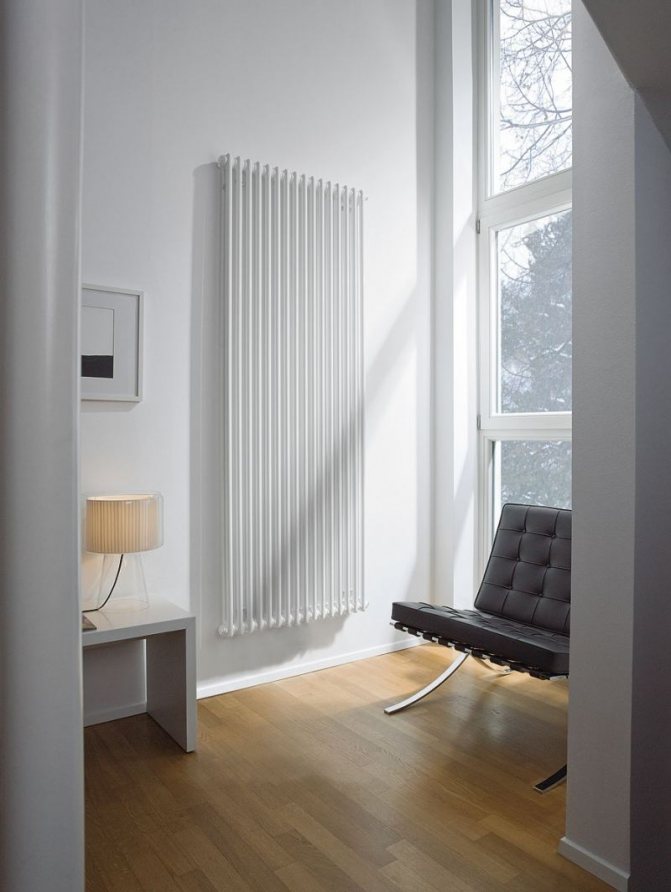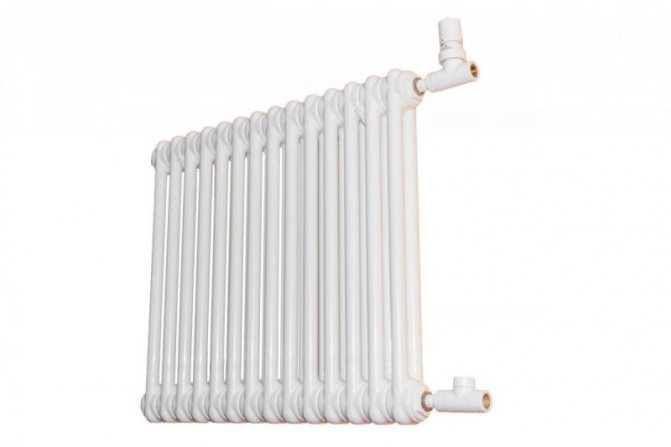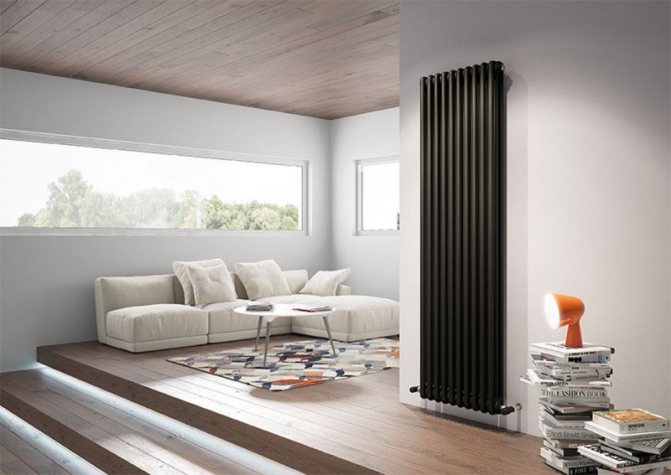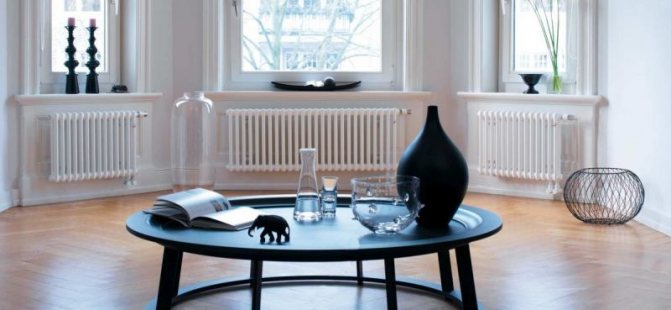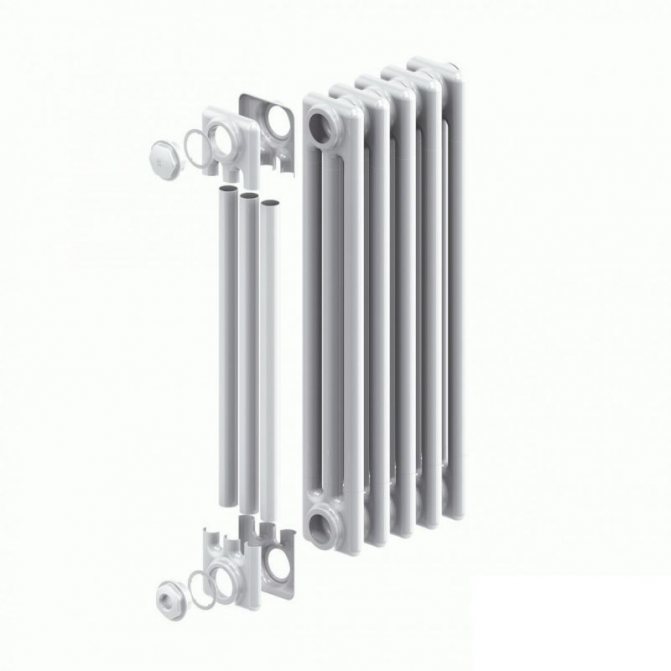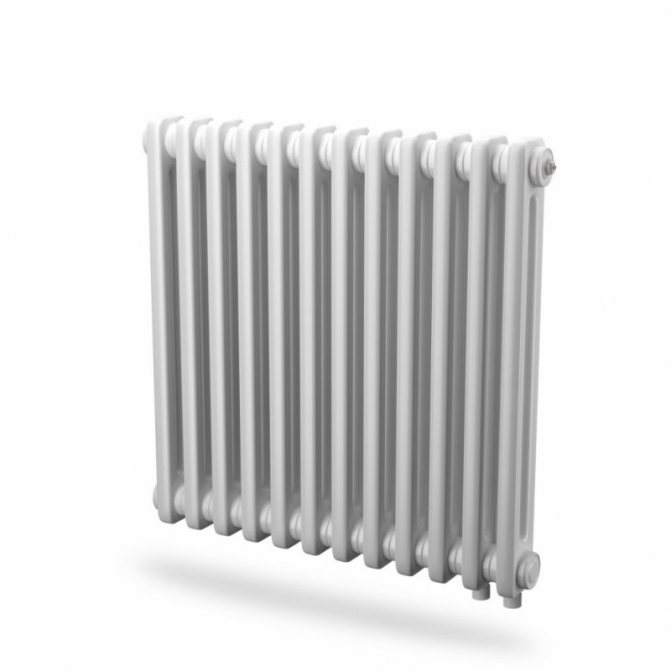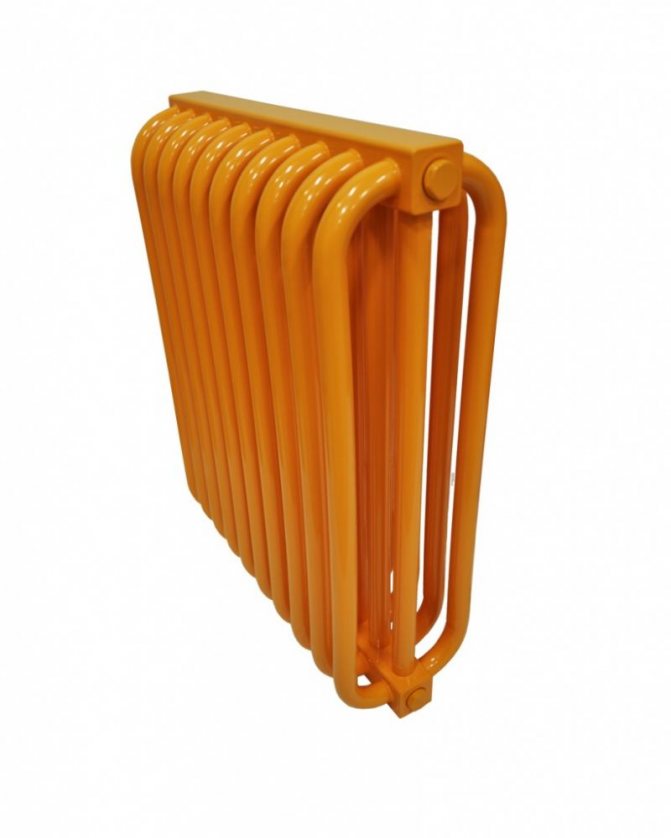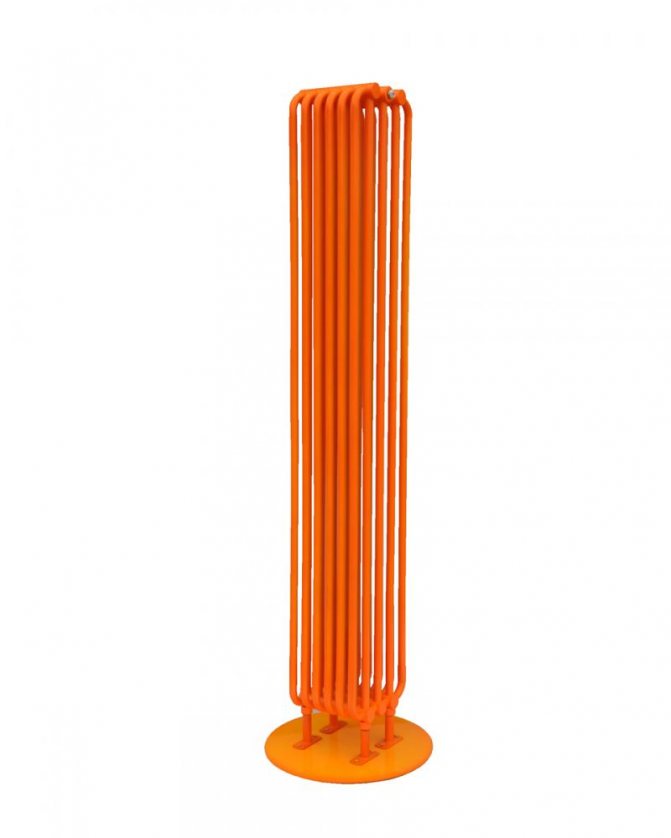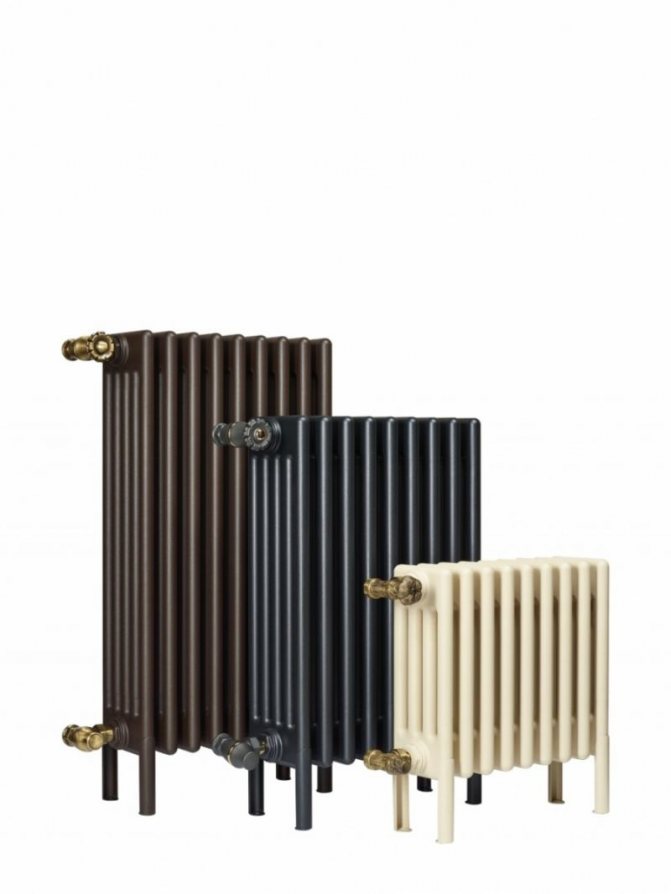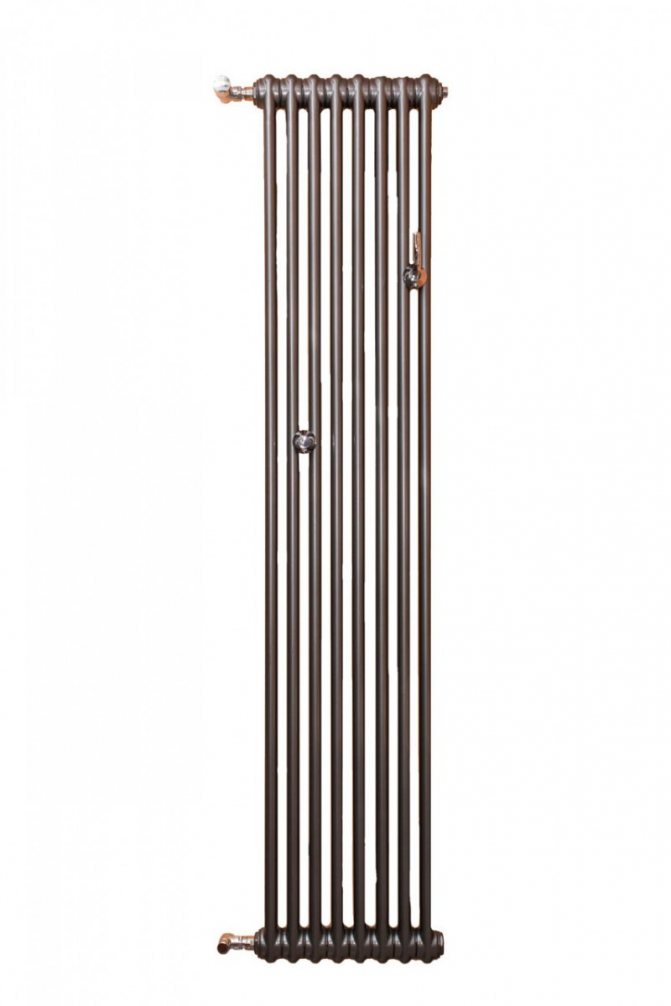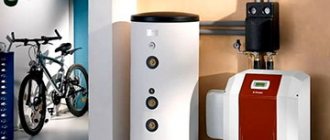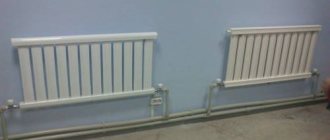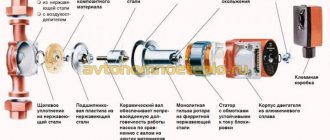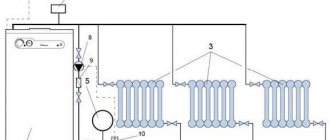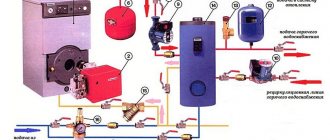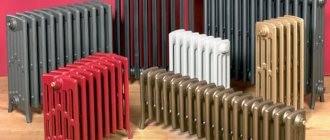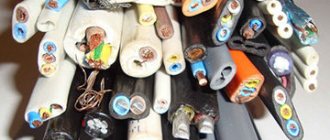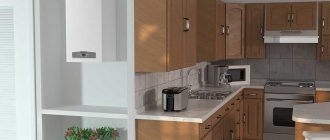Design features
The appearance of tubular batteries is slightly reminiscent of the design of cast iron radiators. The instruments include an upper and a lower collector, between which there are steel tubular bridges. To connect individual elements of the product, universal laser welding is used, which allows you to achieve accuracy and invisibility of the connecting seams.

A distinctive feature of all tubular heating radiators is their strength. On sale, they are presented in a significant variety in shape, size and color design: this greatly simplifies the selection of the most suitable heating device for the interior of a particular room.
Features of tubular devices
Tubular heating radiators are a non-separable metal structure consisting of interconnected steel pipe sections, less often aluminum, copper or stainless steel. The diameter of the tubular elements is 25 mm (the type of section is not limited), the wall thickness is 1 - 2 mm. The configuration of such equipment can be varied, made according to individual sketches to order. Height varies from 20 cm to 3 m, length from 27 cm to 3 m, depth from 32 mm to 300 mm. One section can accommodate 2 to 6 pipes. The choice of the number of sections and the plane of their arrangement (horizontally, vertically) is possible. Straight or complex joints are laser welded so that the seam is invisible. Location wall, floor (installation on legs), room partition, bench. Such batteries are suitable for centralized and autonomous heating systems.
Inside the radiator, the working medium (coolant, water) circulates through the channels, which is supplied heated to a certain temperature. Steel pipes, quickly warming up, begin to give off heat to the space of the room just as quickly. Heat transfer increases with an increase in the number of pipes in one section, its size.
Convector tubular radiators are gaining popularity for stand-alone systems. Each tube is enclosed in a round case. While a high-temperature coolant is supplied to the radiator, the cover protects a person from tactile contact with a hot surface and ensures effective circulation of air masses due to the space between the pipe and the cover. The hot air flow rushes upwards and the room heats up thanks to the powerful heat transfer. The device is equipped with a thermostat.
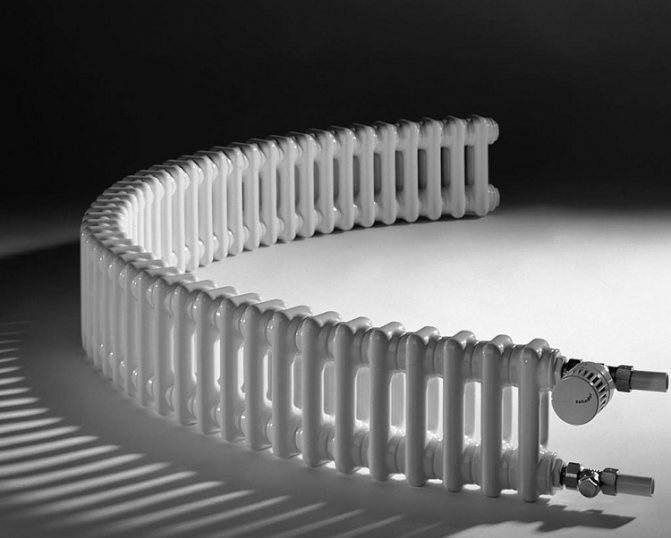

Tubular devices are equipped with thermostats that allow you to control the room temperature
Enterprises engaged in the production of domestic tubular radiators have adapted them to the local operating conditions. These are the heterogeneity and aggressive properties of the coolant, its high temperature in northern latitudes, and irregular pressure in the system. By increasing the wall thickness to 2 mm, the working pressure was increased to 22 atm, making the batteries more resistant to wear.
Optimal installation location
With the help of steel tubular radiators, it is generally customary to equip heating systems with private houses and five-story buildings. High-rise buildings are an unsuitable place for their installation due to frequent water hammering: given that the working pressure of a steel tubular battery is only 6-10 atmospheres, this is fraught with serious consequences.
Any serious pressure surge in the system can cause leakage and damage to the device. Autonomous heating systems are characterized by a lower level of operating pressure - no more than 8 atmospheres. This makes it possible for the tubular radiator to comfortably transfer all overloads inside the circuit.
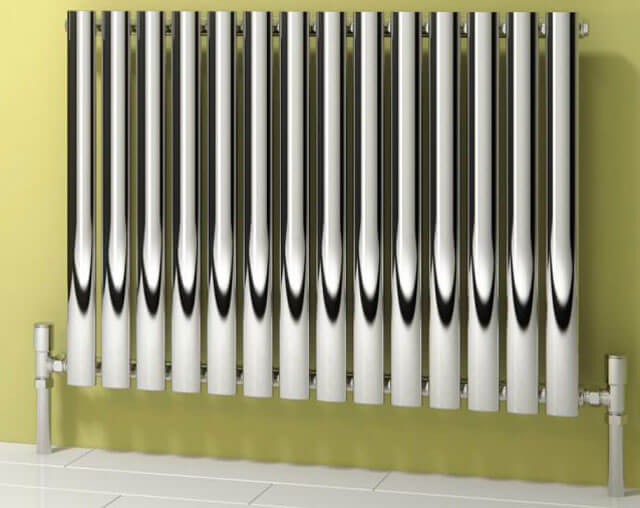

Quite often, medical institutions are equipped with such devices: this is facilitated by the high hygienic characteristics of batteries and a low level of trauma. There are no sharp corners on the products, all bends are smooth and smooth here. In addition, steel tubular radiators are an order of magnitude more durable than their cast-iron counterparts.
What are tubular radiators?
In addition to heating boilers, radiators play an important role in the autonomous heating system, designed to transfer heat from the coolant to the room. The quality of the radiator determines how efficiently the entire heating system will function. On the modern market there are different types of radiators, both cast-iron batteries familiar to us from childhood, and more aesthetic and efficient tubular radiators... They are premium products, meet all modern requirements and have a number of advantages over other types of radiators. Tubular radiators owe their birth to Robert Zender, who in 1930 created the first tubular radiator by analogy with the cooling system of a motorcycle engine.
Characteristics of tubular heating batteries
The material for the manufacture of tubular radiators is most often steel, which gives them special strength and reliability.
Main technical parameters of tubular steel radiator:
- Height... It can be from 30 to 300 cm.
- Number of pipes... There are no restrictions here: there are models with one tube, and there are models with a much larger number of jumpers.
- Depth... Approx. 225 mm. One row can contain 1 - 6 elements. The formation of the cost of the device is influenced by the working volume and parameters of the jumpers.
- Sectional Distance... There are two options: 65 and 45 mm. Radiators with a section pitch of 65 mm are mainly used in hospitals, schools and other institutions where there are very high hygienic requirements.
- Wall thickness... It can be from 1 to 2 mm. For Western products, a thickness of 1-1.5 mm is characteristic. For domestic devices, it is slightly larger - 2 mm.
- Section section... The standard version is round tubes with a diameter of about 25 mm. Less commonly, you can find products with flat, rectangular, oval and triangular sections.
A matter of choice
The selection of such parameters as the color and shape of tubular heating devices has no effect on the operation of the device. and is selected based on its own aesthetic taste and appropriateness of use in the interior of the room.
The number of sections is selected depending on the heated area. On average, 100 watts of thermal energy is needed to heat 1 sq / m of a room. The instructions for each device indicate its power.
To calculate the number of radiators that are required for installation in a room with an area of 30 m2, 30 * 100 = 3000 V are required, that is, the area of the room is multiplied by the required amount of energy. Then divide the resulting number by the power of the radiator, for example 3000: 1500 = 2; in this case, the power of one heating element is 1500 W, and 2 such devices must be installed to heat the room.
Domestic radiators have a metal thickness of at least 2 mm. Such devices should be installed in central heating systems. If you need to install heating elements in a private house, where the coolant pressure is not too high, then the ideal option would be to purchase imported devices with a material thickness of 1 - 1.5 mm.
Main varieties
Horizontal and vertical steel radiators are distinguished by the type of tube arrangement. Large offices and halls are usually equipped with horizontal appliances. The scope of vertical tubular batteries is in private homes, hospitals and schools. The design features of vertical models contributes to a visual increase in the height of the premises. In addition, they hardly accumulate dust.
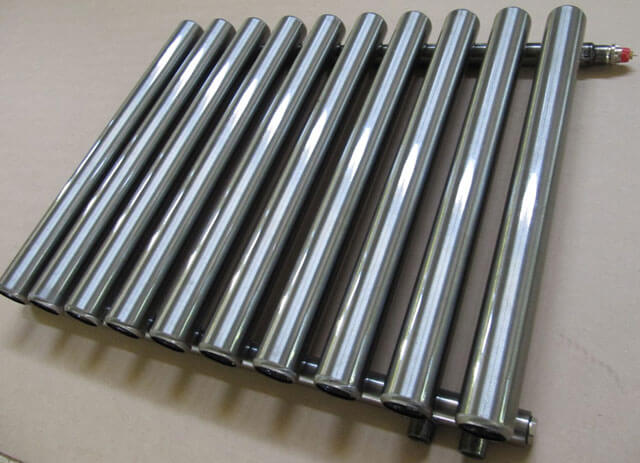

The shape of this type of heating devices can be angular, flat, radius and design.In corner models, two sections are used, which are located at a certain angle to each other. In this case, it is possible to adjust the angle, depending on the characteristics of the interior. Flat models are characterized by a single-row arrangement of tubes: this form of the device is the most popular among buyers. The radial configuration assumes the presence of an arc. Designer models are designed with special originality. One option is to bend the vertical tubes to create a wavy effect.
Advantages and disadvantages
When considering a steel tubular radiator as a potential option for equipping your home, you need to become familiar with its strengths and weaknesses.
Advantages of tubular radiators:
- Resistant to increased water hardness... Corrosion is almost unknown to these batteries.
- A significant number of color and shape options... This makes it much easier to choose the most suitable option for the design of the room.
- Safety... There are no sharp corners on products of this type, which explains their popularity in families with small children.
- Easy to operate and maintain... The design of the tubular radiator does not contribute to the accumulation of dust. They are easy to clean and repair. Adjusting the water supply is very convenient here. If desired, the device can be placed under plasterboard sheathing.
- Convenience of commutation... Modern models allow both bottom and side connection.
- Reliability... For production, only modern materials and the latest technologies are used.
- The optimum ratio of price and quality.
When should you choose a tubular radiator?
Tubular radiators are installed in medical institutions because they have good hygienic properties. They do not accumulate dust, they are less traumatic due to the smooth bending of pipes and the absence of sharp corners, and also more wear-resistant than conventional radiators.
In private homes, steel tubular radiators
will fit perfectly into any interior... They quickly react to the control command and easily acquire the temperature set by them. Thanks to the convection heating of the room, the tubular radiator distributes heat better. For a living space, this is just a godsend!
The originality of design solutions in the execution of tubular radiators knows no boundaries. An ordinary radiator can become a real work of art and a source of pride for the owner of the house. Convector tubular radiators have double walls, which greatly enhances heat transfer. In a large hall where the whole family gathers on cold winter evenings, such a radiator will become an irreplaceable household appliance and a beautiful piece of furniture.
Decorative benefits
Tubular radiators are characterized by special grace and lightness. If desired, you can find models of non-standard configuration (semicircular sections, radiator benches, etc.), the cost of which is much higher. Especially worth noting is the wide range of colors of tubular steel appliances.
The most popular are light and dark solutions. Darker radiators have better heat dissipation. Bronze, metallic, lacquered wood, mother-of-pearl, aged bronze are considered more interesting color schemes. Good efficiency is observed in chrome-plated products.
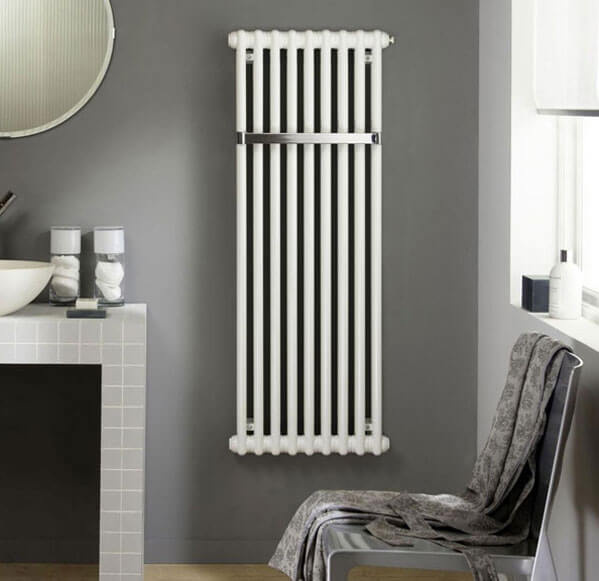

In such popular interior styles as vintage and loft, you can find more original design of heating devices. In some cases, special anti-corrosion agents are applied to the metal surface.
A transparent varnish is used as a finish. An example of design is the use of grilles to make the radiator more aesthetically pleasing. In addition, this creates additional protection against mechanical stress. You can choose a mesh of almost any shade: the price remains stable.
Tubular radiator in the interior
Steel tubular heating radiators look spectacular, therefore they are organic for any interior. They are combined with both antiques and high-tech designs.The whole secret is in the simplicity of the design, from which a variety of shapes are created, a wide color palette and the choice of a convenient location.
In addition to the classical arrangement of the appliance on the wall under the window opening, the tubular radiator can be used as a bench, wall partition, table-top legs, railings, mirror framing on the wall, columns of a false fireplace. Such a radiator is equally aesthetic and functional in any space: a hall, a kitchen, a bath, a nursery, an exhibition hall, a cafe, institutions with increased sanitary and hygienic requirements, etc. The need to hide batteries has disappeared, they have become a tool in creating a unique interior design.
The steel tubular radiator is distinguished by a mass of positive qualities, is technically efficient, safe, and most importantly takes its rightful place in the room, endowing it with individuality and warmth.
Steel Tubular Radiator Market Overview
Tubular steel radiators are represented on the sanitary equipment market in a significant variety. Along with the standard designs, you can find real works of art. The same goes for the variety of manufacturing firms.
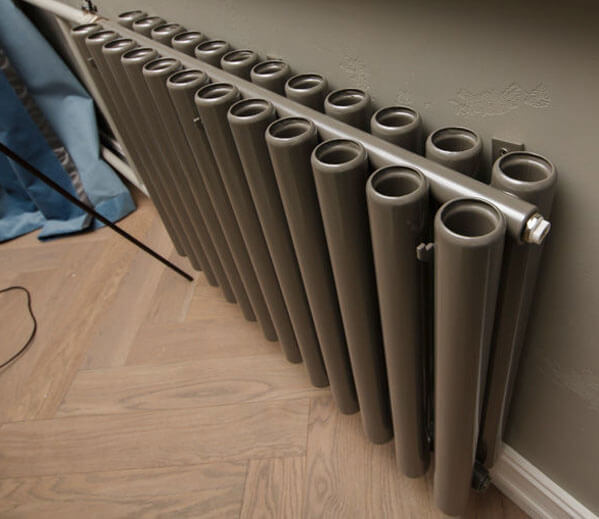

For our conditions, the most suitable option are radiators from domestic companies, in the manufacture of which the Russian climate, water characteristics, features of heating systems and other important parameters are taken into account. As for foreign products, German, Czech, Turkish, Polish and Italian models are of the highest quality.
Turkish
They differ in quite good quality. At the same time, the assortment of Turkish steel batteries is distinguished by some scarcity of assortment. As a rule, these are panel radiators of a fairly inexpensive cost. Licensing of products is mainly carried out by well-known Western European firms, which allows you to be calm about their quality.
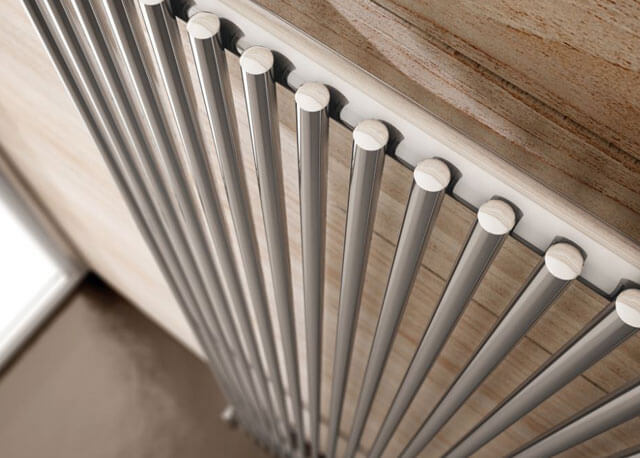

German
Especially worth noting is the high quality of the tubular steel radiators of the German company Zehnder. The products of this company are distinguished by a significant technological diversity, with the ability to connect to hot water pipes, open water heating systems and electrical circuits. German plumbing firms specialize in non-standard heating devices. These models can be very tall or super low, with a very rich color gamut (700 shades). Consider the high cost of Zehnder products.
Speaking of German radiators, the Swiss-German company Arbonia is worth mentioning. These products are distinguished by their excellent design, high technical characteristics and quality. At the same time, the cost of Arbonia heating devices is quite acceptable for a domestic buyer.
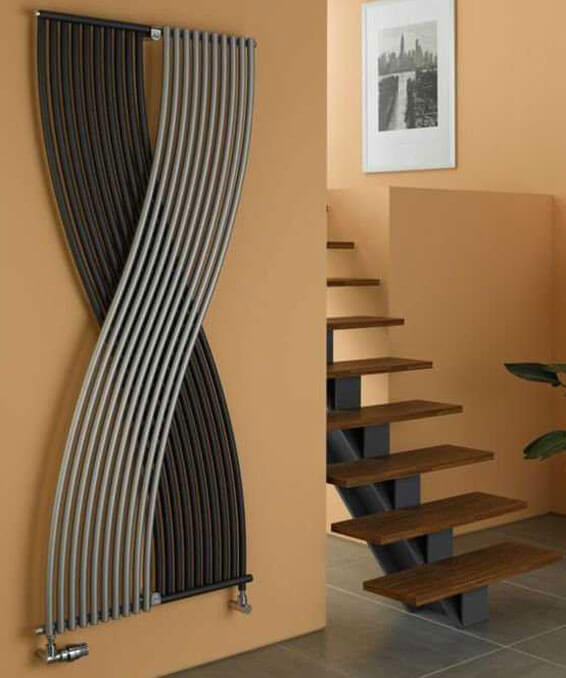

Device design
Tubular heating radiators of a home heating system have recently appeared on the market for devices designed for heating rooms. However, they hold their positions firmly. The owners of country houses give positive reviews about them. They are graceful, thin, although they resemble old cast iron batteries.


Photo of the scheme of a tubular radiator
The design of tubular radiators for houses and apartments is quite simple:
- upper manifold,
- steel tubes,
- lower manifold.
Tubular radiators differ from other types of radiators by their unique welding. If bimetallic radiators are twisted, then the tubular batteries are welded. They do laser welding, the seam is smooth and barely perceptible to the eyes. Tubular heating radiators are quite durable, they will perfectly suit any room, regardless of its purpose.
They are produced in different sizes, shapes, colors.A tubular view of a radiator for a heating system can be built into the water heating system of low-rise buildings. They have a small thickness, but pressure drops in heating will not blow them up. Tubular radiators for heating are not afraid of water hardness. It has no effect on them. They are also not subject to corrosion.
Italian
Italian radiators are characterized by a high level of quality and excellent decorative characteristics. At the same time, one should take into account their adaptation to European operating conditions, which differ from the realities in our country. However, high technical characteristics and convenient connections make Italian devices very popular. This is especially true of the products of the Royal company, which are distinguished by quality, ease of maintenance, reliability and durability. The cost of Royal radiators is quite high.
Chinese
The most budgetary model of a metal tubular radiator is the Chinese-made Oasis battery. Despite its low cost, the device is distinguished by good durability, resistance to aggressive effects and the absence of operational restrictions. A number of models are manufactured taking into account the specifics of domestic heating networks. Tubular heating batteries Oasis have the most positive reviews. The company also specializes in the manufacture of standard bimetallic heating radiators with excellent thermal performance and affordable cost.
Zehnder Charleston 3057
Stock assortment of 3 tubular radiators 3057, with side connection. Height 570 mm. White color.
| Zehnder Charleston 3057 | Model | Number of sections in the radiator | Height | Center distance | Depth | Width | Heat dissipation | Price | |
| ΔT = 50K (75/65/20 ° C) | ΔT = 60K (90/70/20 ° C) | ||||||||
| 3057 /08 | 8 | 566 mm | 500 mm | 100 mm | 392 mm | 456 Wt | 576 Wt | RUB 10,216 | |
| 3057 /10 | 10 | 484 mm | 570 Wt | 720 watts | RUB 12,770 | ||||
| 3057 /12 | 12 | 576 mm | 684 Wt | 864 Wt | RUB 15,324 | ||||
| 3057 /14 | 14 | 668 mm | 798 Wt | 1008 Wt | RUB 17,878 | ||||
| 3057 /16 | 16 | 760 mm | 912 Wt | 1152 Wt | RUB 20,432 | ||||
| 3057 /18 | 18 | 852 mm | 1026 Wt | 1296 Wt | RUB 22,986 | ||||
| 3057 /20 | 20 | 944 mm | 1140 Wt | 1440 Wt | RUB 25,540 | ||||
| 3057 /22 | 22 | 1036 mm | 1254 Wt | 1584 Wt | RUB 28,094 | ||||
| 3057 /24 | 24 | 1128 mm | 1368 Wt | 1728 Wt | RUB 30 648 | ||||
| 3057 /26 | 26 | 1220 mm | 1482 Wt | 1872 Wt | RUB 33,202 | ||||
| 3057 /28 | 28 | 1312 mm | 1596 Wt | 2016 Tue | RUB 35 756 | ||||
| 3057 /30 | 30 | 1404 mm | 1710 Wt | 2160 Wt | RUB 38 310 | ||||
Radiators Charleston 3050.
3 tubular with lateral eyeliner (fold assortment). Height 500 mm. White color.
| Zehnder Charleston 3050 | Model | Number of sections in the radiator | Height | Center distance | Depth | Width | Heat dissipation | Price | |
| ΔT = 50K (75/65/20 ° C) | ΔT = 60K (90/70/20 ° C) | ||||||||
| 3050 /08 | 8 | 500 mm | 434 mm | 100 mm | 392 mm | 416 Wt | 520 Wt | RUB 9 856 | |
| 3050 /10 | 10 | 484 mm | 520 Wt | 650 Wt | 12 320 RUB | ||||
| 3050 /12 | 12 | 576 mm | 624 Wt | 780 Wt | RUB 14,784 | ||||
| 3050 /14 | 14 | 668 mm | 728 Wt | 910 Wt | RUB 17,248 | ||||
| 3050 /16 | 16 | 760 mm | 832 Wt | 1040 Wt | RUB 19,712 | ||||
| 3050 /18 | 18 | 852 mm | 936 Wt | 1170 Wt | RUB 22,176 | ||||
| 3050 /20 | 20 | 944 mm | 1040 Wt | 1300 Wt | RUB 24 640 | ||||
| 3050 /22 | 22 | 1036 mm | 1144 Wt | 1430 Wt | RUB 27,104 | ||||
| 3050 /24 | 24 | 1128 mm | 1248 Wt | 1560 Wt | RUB 29,568 | ||||
| 3050 /26 | 26 | 1220 mm | 1352 Wt | 1690 Wt | RUB 32,032 | ||||
| 3050 /28 | 28 | 1312 mm | 1456 Wt | 1820 Wt | RUB 34,496 | ||||
| 3050 /30 | 30 | 1404 mm | 1560 Wt | 1950 Wt | RUB 36,960 | ||||
Zehnder Charleston 3037
Three-tube with lateral eyeliner (fold assortment). Height 366 mm and white.
| Zehnder Charleston 3037 | Model | Number of sections in the radiator | Height | Center distance | Depth | Width | Heat dissipation | Price | |
| ΔT = 50K (75/65/20 ° C) | ΔT = 60K (90/70/20 ° C) | ||||||||
| 3037 /08 | 8 | 366 mm | 300 mm | 100 mm | 392 mm | 312 Wt | 392 Wt | RUB 9,120 | |
| 3037 /10 | 10 | 484 mm | 390 Wt | 490 Wt | 11 400 rub. | ||||
| 3037 /12 | 12 | 576 mm | 468 Wt | 588 Wt | RUB 13,680 | ||||
| 3037 /14 | 14 | 668 mm | 546 Wt | 686 Wt | RUB 15,960 | ||||
| 3037 /16 | 16 | 760 mm | 624 Wt | 784 Wt | RUB 18,240 | ||||
| 3037 /18 | 18 | 852 mm | 702 Wt | 882 Wt | RUB 20,520 | ||||
| 3037 /20 | 20 | 944 mm | 780 Wt | 980 Wt | RUB 22 800 | ||||
| 3037 /22 | 22 | 1036 mm | 858 Wt | 1078 Wt | RUB 25,080 | ||||
| 3037 /24 | 24 | 1128 mm | 936 Wt | 1176 Wt | RUB 27 360 | ||||
| 3037 /26 | 26 | 1220 mm | 1014 Wt | 1274 Wt | RUB 31,920 | ||||
| 3037 /28 | 28 | 1312 mm | 1092 Wt | 1372 Wt | RUB 31,920 | ||||
| 3037 /30 | 30 | 1404 mm | 1170 Wt | 1470 Wt | RUB 34,200 | ||||
